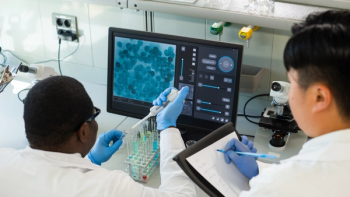
- Pharmaceutical Executive-01-01-2022
- Volume 42
- Issue 1
Boosting Immunotherapies
Oncology and rare disease are ready to reap the benefits of COVID drug development.
COVID-19-induced setbacks in oncology and rare disease research and development have had far-reaching impact over the past 22 months. Amid lockdown mandates, many trials were halted due to lab shutdowns. Some oncology researchers switched gears to investigate COVID treatments, where their crossover knowledge was in demand. A loss of private funding for research—important to oncology and rare disease—also slowed progress. However, as we move into 2022, these disease areas are poised to bounce back—and take off—ironically, due in part to COVID.
Despite its negative effects, COVID has had some positive influence and is now helping to move the needle in a forward direction. Messenger RNA (mRNA) and monoclonal antibodies, which were already being used in cancer research well before COVID, were spotlighted in the fight against COVID, stimulating increased appreciation for their usefulness, and general awareness and interest in the science of immunotherapy. Outside the lab, COVID-prompted processes such as telehealth, decentralized trials, and the push for accelerated timelines have been valuable in the drug development process, too. Finally, the continued biotech boom, led by oncology and rare disease companies, is helping to drive the revival. This combination of factors creates a healthy future for oncology and rare disease drug development.
Advancing science
Despite advances in RNA over the past few decades, mRNA did not become mainstream until 2020, when Pfizer and Moderna used the technology to create their COVID vaccines. The scientific landscape shifted in a matter of months, and immunology took center stage. Though these vaccines were the first of their kind to be used at this scale, there were decades of research in RNA-based technology that preceded it, much in oncology and rare disease.
“While the pandemic rapidly expanded awareness of next-generation vaccines designed to enhance anti-viral immunity, the oncology field has been at the forefront of interrogating cutting-edge immunotherapies for some time,” says Christopher Arendt, PhD, head of Takeda’s oncology cell therapy and therapeutic area unit.
A breadth of modalities—from mRNA therapies to antibody-based immunomodulators to cell-based therapies—are being explored by companies like Takeda that seek to harness the power of the immune system to help people with cancer live longer and better lives.
“We have long had an obligation to our patients to continue to investigate, invest in, and secure access for new technologies and modalities, but there’s no denying the impact COVID has had on the healthcare industry and the people we serve,” says Arendt. “For the public, the elevated discourse around research and development, specifically for novel approaches, has helped to shape awareness and acceptance of immunotherapies. For researchers, COVID has unlocked new ways to translate insights from patients and the clinic into innovative therapeutics that have the potential to transform lives.”
When PTC Therapeutics was founded in 1998, CEO Stu Peltz recognized the potential of post transcriptional mechanisms to advance medical science and help patients in need, specifically in the area of rare disease. Since then, PTC has developed three proprietary technologies to screen for, and identify, small-molecule drug targets within the RNA translation process. The company has identified hundreds of targets with therapeutic tractability and has succeeded in identifying potential treatments for spinal muscular atrophy (SMA), Huntington’s disease, and others.
“Disruptive technologies will ultimately always be critical for industries’ future success,” says Matthew Klein, MD, chief operating officer at PTC. “At the end of the day, much of the work companies are doing that utilizes mRNA-based technologies has opened up new fields of medicines, and because of this, we have been able to deliver lifechanging therapies to patients in need.”
While the pandemic helped accelerate the acceptance of these drugs, their potential stretches far beyond the current pandemic. There is a growing understanding and appreciation that many diseases have an immune system component. As such, future solutions to solve these problems are highly likely to involve immune modulating agents.
“The adoption of immunology was hampered by two things—the field’s novelty and the immune system’s complexity,” says Daniel Getts, CEO and co-founder of Myeloid Therapeutics. “Every tissue in the body has its own built-in immune system that communicates and is supplemented by those elements of the immune system most commonly associated with immunology—the bone marrow, thymus, spleen, etc. The complex interplay between the immune system and organs/body tissues is daunting to non-immunologists and, admittedly, it takes time to learn. But the amazing interplay between the immune system and bodily organs is where we find a treasure trove of future druggable targets, and this therapeutic space has only just started to be tapped.”
Throughout history, a number of immune drugs have been accepted, including smallpox and polio vaccines. More recently, the success of TNF blockade played a significant role in the emergence of monoclonal antibody therapies (a therapeutic modality made possible because of immunology). The success of checkpoint inhibitors and cell therapies have further catalyzed the space. Many medical advances have their routes in immunology.
While the COVID mRNA vaccines are preventative, mRNA vaccines for cancer are therapeutic. There is growing interest in creating personalized mRNA cancer vaccines, as it is difficult to find an all-in-one cancer vaccine. Researchers are exploring combining mRNA vaccines with other immune-based therapies, such as checkpoint inhibitors, adoptive T-cell therapy, and monoclonal antibodies to achieve better results. Other RNA mechanisms, such as small interfering RNA (siRNA), RNA interference (RNAi), and antisense oligonucleotides (ASOs), also are being studied in the areas of oncology and rare disease.
“At Takeda, we are working with our scientists and partners to continue advancing the development of immunotherapies by exploring novel strategies and combination approaches that have the potential to outsmart cancer in ways never seen before,” says Arendt. “We believe there are exciting discoveries ahead in this field of medicine—and we are proud to be a part of it.”
Beyond the bench
As pharma was forced to flex its digital muscles and adopt flexible practices during COVID, the therapeutic areas of oncology and rare disease especially benefitted. Due to the nature of the illnesses, it can be difficult for these patients to obtain treatments—even outside of COVID—but telehealth opened the door to increased accessibility. If telehealth and decentralized trials can continue to be complemented by remote practices such as shipping medicines and accepting e-signatures, research will continue to benefit.
“While we all wish the pandemic never happened, this innovation in telehealth and digital medicine made progress that otherwise would have taken a decade,” says Debra Patt, MD, PhD, MBA, FASCO, executive vice president at Texas Oncology, a practice in The US Oncology Network, and professor at Dell Medical School at The University of Texas at Austin.
Her organization, which was an early adopter of telemedicine, has pivoted to deliver a suite of services with telehealth. This allows patients to have cancer diagnosed and treated just in time and where they are. As a large statewide practice, Texas Oncology also implemented an application-based symptom monitor that interacts with its clinical team. By having a digital tool for patients to report symptoms and obtain symptom management, symptoms can be controlled faster, improving the patient experience.
COVID also demonstrated the ability to implement accelerated timelines. “I think after the progress seen in COVID vaccine approval, we see the value of prioritization and collaboration in catalyzing scientific discovery and results,” says Patt.
In the case of rare disease, many patients, families, advocacy groups, physicians, and companies hope that the changes that have improved access to care and to clinical trials fuel a greater role for telehealth in both these areas. “This will require a collaborative effort that will include regulatory authorities, payers, physicians, and companies,” says Klein.
Boom time
Oncology and rare disease continue to lead the way amid the biotech IPO boom. In 2021, there were 42 oncology IPOs, compared with 34 in 2020, 15 in 2019, and 17 in 2018. Rare disease takes second place, with 10 IPOs in 2021, compared with 12 in 2020, three in 2019, and eight in 2018, according to BioPharma Dive stats from November 2021.
Bill Sibold, executive vice president and head of Sanofi Genzyme, a pioneer in rare disease drug development, says the focus on oncology is because there is a high unmet need. “Nowadays, many cancers can be effectively treated, but for some cancers, like lung or metastatic breast cancer, it is still a terminal illness,” he says. “In these and other virulent cancers, even a short extension of life is a win. It can mean the difference between being there for that graduation and wedding or missing it. Having an industry committed to helping people have as many memories as possible makes an impact and, therefore, creates value—for all of us.”
One of the reasons rare disease is so important is because people have realized that the value of investment in this area is demonstrated by the ability to give people a higher quality of life than ever before. “You can do small trials with very few patients, because there are such few patients, and get meaningful results to help people affected by rare disease,” says Sibold. “There are 7,500 rare diseases, and we only have treatments for about 500. We have a long way to go. So, if people are thinking about where to place their bet, they would be smart to study rare disease areas and find more treatments.”
As immunology advances, it can potentially be applied to a large number of targets in all therapeutic areas, and that sets it apart. “Following the spotlight the pandemic put on RNA technology over the past year, as well as the rapid progress of mRNA vaccines, I believe that investment in this area is poised to continue to gain momentum,” says Klein. “Because these drugs are relatively simple to manufacture, are cost effective, and can target previously undruggable pathways, this technology can be rapidly developed whether you are a big pharma company, a small biotech company, or an academic lab.”
Elaine Quilici is a Senior Editor for Pharm Exec. She can be reached at
Articles in this issue
almost 4 years ago
Keeping Tabs on Quality: The Rise of Digitalalmost 4 years ago
China Invests in Building Biotechalmost 4 years ago
Branding Takes on a New Lookalmost 4 years ago
Addressing Access Burdensalmost 4 years ago
Meeting the Patient—Virtuallyalmost 4 years ago
The Age of Influencealmost 4 years ago
Pharma’s Psychedelic Experiencealmost 4 years ago
Supply Chain Procurementalmost 4 years ago
Our View on 2022: Pharm Exec’s Annual Industry Outlookalmost 4 years ago
Breaking New Ground in BiopharmaNewsletter
Lead with insight with the Pharmaceutical Executive newsletter, featuring strategic analysis, leadership trends, and market intelligence for biopharma decision-makers.




